Article
Molokai: A Drive Through "Old Hawaii"
Author(s):
The little island of Molokai is not the Hawaii of glitz and glamor -- and that is the way the locals like it. The island is worth a visit because it is one of the few places left where you can still see what life was like in Old Hawaii.
Photography by the authors.
Tourists who choose to visit Hawaii's Molokai tend not to rhapsodize about another exciting day in paradise. The little island of Molokai is not the Hawaii of glitz and glamor — and that is the way the locals like it. This tiny island is worth a visit because it is one of the few places left where you can still see Old Hawaii.
Your hotel choice is easy -- there’s only one. The Hotel Molokai is simple, but it does a pretty good job of looking after its guests. There are also condominium options.
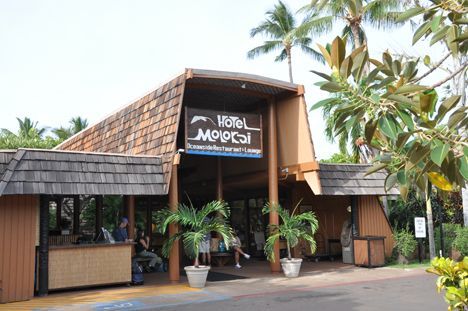
The Hotel Molokai has an oceanfront location, a restaurant with nightly entertainment, and a pool. It’s only two miles to the ferry location at Kaunakakai.
There’s an Alamo car rental office at Molokai’s small airport. Most landlubbers would enjoy the ferry trip from Maui, but handling the afternoon return going back east to Maui against the current of the Molokai Channel can be unpleasant. Hint: Consider ferrying in to the island, and then flying out.
It’s relatively easy to cover the entire distance of this 38-mile-long, 10-mile-wide island. If you want to get to the east end of the island to see the sunrise, however, you’ll have to leave the hotel in the dark, and the 27-mile-long winding road to Halawa becomes tortuous and close to the water’s edge about halfway through your trip. You journey will end at the tiny green-painted wooden Ierusalema Hou Church, which was built in 1948. If the light allows it you may also catch a glimpse of one of the two local waterfalls as you drive to the church.
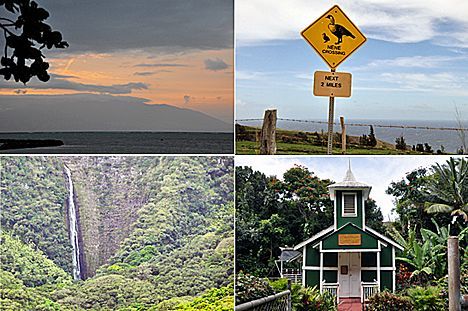
The road carries warnings on the habitat of the Nene, the Hawaiian state bird, a variety of Hawaiian Goose. A rare land bird unknown even to Audubon Society, it was threatened with extinction until protected in 1949.
On the way back from Halawa you’ll pass, on the right, the Church of the Lady of the Seven Sorrows, one of four churches built on the island by Father Damien, the patron saint of the Diocese of Honolulu and of Hawaii,, who came to look after the patients with Hansen’s Disease exiled to the island. Like other churches on this island of the Old Hawaii, it doors are open to travelers.
Close to the 14-mile marker on the left, beside a pig farm. stands a monument dedicated to Ernest Smith and Emory Bronte, the intrepid aviators who, in 1927, made the first civilian Trans-Pacific crossing between California and Hawaii. During their flight in their Travelair plane, the City of Oakland, they ran out of fuel over the south shore of Molokai and crash landed here.
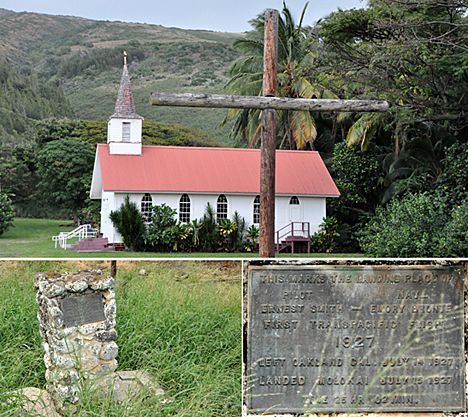
Ernest Smith, an airline pilot, and Emory Bronte, a merchant marine captain his navigator, took off from Oakland, Calif., in a 27-foot long Travel Air single-engine monoplane on July 15, 1927, six weeks after Charles Lindbergh’s famous flight to Paris. Smith and Bronte were aiming for Honolulu, but fell 100 miles short. It was still a record and a brave adventure.
A few miles farther west on the south side of the highway is another reminder of the real hero of Molokai, Father Damien. Born Jozef De Veuster, Father Damien was a Roman Catholic preist from Belgium who came to Molokai to minister to leprosy patients, who had been quarantined on the island by the government. (He eventually contracted and died of the disease.) The morning light warms the walls of St. Joseph’s, another church built by this modest man. Inside, beyond the unlocked door, all is cool and peaceful.
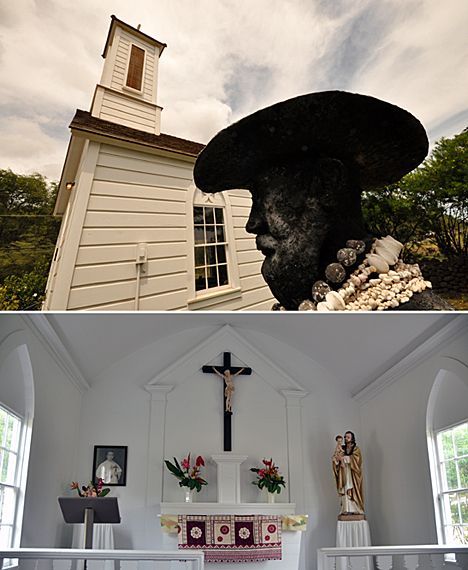
Father Damien built four churches on Molokai, two still standing. He is, of course, beloved on this small island — and across the world.
All along the coastal drive back to town lies evidence of the royal fishponds created 600 to 700 years ago, which are now being restored. In the Hawaiian village community, the fishponds provided most of the protein in the native diet. It is exhilarating to get out of the car and stand beside those ancient walls.

The fishponds were cleverly designed: The walls and gates allowed small fish to come in from the ocean, but the openings were so small predators could not enter. As the small fish grew, they soon became ready for the kitchen.
The drive on to the West End of the island now swings north to the Molokai Museum and Cultural Center, where visitors can read about the island’s history and enjoy its shell collection. The former R.W. Meyer Sugar Mill stands beside the museum.
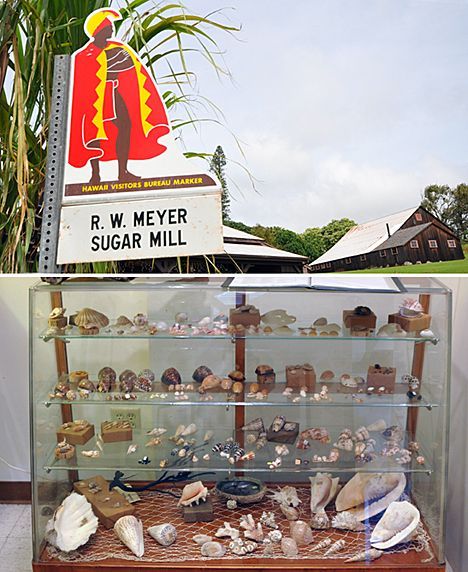
The R.W. Meyer Sugar Mill, built in 1878, is the oldest in Hawaii. It was restored with assistance from the Meyer family and is now listed on the National Register of Historic Sites.
The choice now is to head west or continue on to the overlook above the Kalaupapa Peninsula to where the ceremonial 6-foot-high Phallic Rock sits on a small hill a five-minute walk above the overlook car park. The site, now within the Palaau State Park in a grove of ironwood and eucalyptus trees, is sacred. Infertile women bearing offerings have come here for centuries, spending the night in the hopes of some day conceiving a child. They still come -- fresh flowers lie on the ground around Phallic Rock
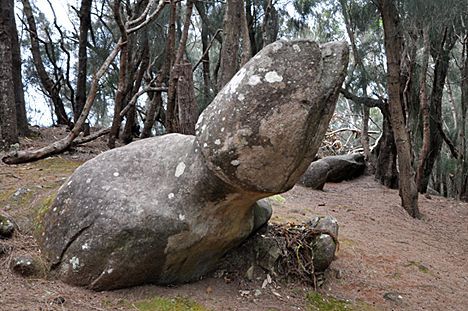
Phallic Rock is located 200 yards from the Kalaupapa Lookout, at the base of Nananhoa Hill.
As the sun sinks lower in the sky, it’s time to move on to Maunaloa. The little town there has fallen on difficult times. A ranch that had been a second choice for tourists looking for accommodations has closed. Fortunately, still there on the Mauna Loa Highway is a village store called Big Wind Kite Factory. It’s owned by an upbeat couple who would raise anyone’s spirits, although we are told they are not true islanders -- they have been here for only 35 years!

Jonathan Socher, so-owner of Big Wind Kite Factory, used to write jokes for Mel Blanc, the comedian who was, among other things, the voice of Bugs Bunny.
We ask Jonathan Socher why he and his wife, Daphne, chose making kites their career. He replies, “We’re not sure we really chose this; it was really the only thing that worked.” They’d traveled all over the world: Greece, South America, and India, buying in some places and selling in others but, in 1974, they went back to Los Angeles to lend a hand to the family business of selling military surplus. “We helped run the family business into bankruptcy,” says Socher.
A friend told him a man was selling kites on the beach near the Sheraton Waikiki Hotel on Honolulu, making $200 to $300 a day at weekends. “I was a young misguided hippie, but I found this location on Molokai and opened shop. I also found that this was the life,” he says. “I tell customers you’re looking up, the kite string is pulling the tension out of you, and the more kites you buy the lighter your luggage gets.”
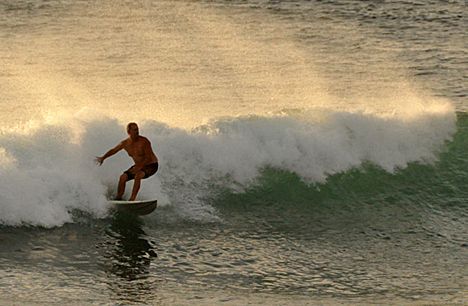
At the West End beaches surfers enjoy the waves and continue long after the sun has set.
The Andersons, who live in San Diego, are the resident travel & cruise columnists for Physician's Money Digest. Nancy is a former nursing educator, Eric a retired MD. The one-time president of the New Hampshire Academy of Family Practice, Eric is the only physician in the American Society of Travel Writers. He has also written five books, the last called The Man Who Cried Orange: Stories from a Doctor's Life.




